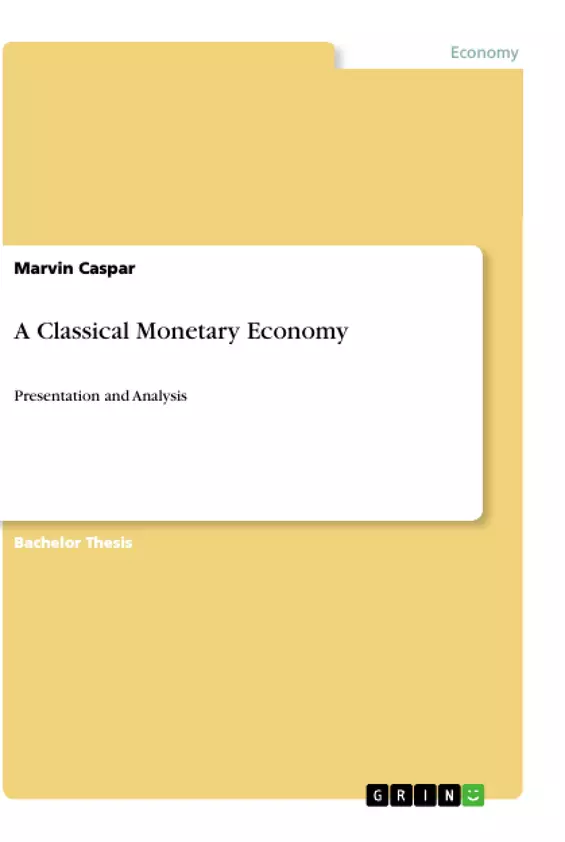The aim of this thesis is the presentation and analysis of a classical monetary economy. Modelling is considered over different periods, which implies a dynamic optimization problem. Under simple and comprehensible assumptions, household side and producing firms will be modelled. In the market equilibrium, interrelations and influences of different variables are presented under participation of the monetary authority.
This analysis makes use of various mathematical tools, approximation methods and log-linearizations around steady states, which requires a certain level of abstraction. Thereby mathematical complexity is always kept to a minimum. The central issue is whether the price level is determined or not. Indeterminacy leads possibly to an infinite number of equilibria, which jeopardizes meaningful modelling. Hursey and Wolman (2010) lamented the fact that most monetary models involve the problem of multiple equilibria which makes it impossible to make accurate statements.
The primary objective is to promote an understanding of influencing monetary policy, especially in terms of inflation rate and price level. This thesis will show how monetary policy affects different macroeconomic variables. Furthermore, the question of optimal monetary policy will be discussed. It is important to point out that modelling a monetary economy can provide meaningful information for policy decisions. In particular, the monetary authority can be advised on its decision making by the present analysis. Overall the model presented in this work is mainly based on the work of Gali (2015), and the notation used there is predominantly adopted.
Inhaltsverzeichnis (Table of Contents)
- 1 Introduction
- 2 Households and Firms
- 2.1 Model Assumptions
- 2.2 Household Utility Problem
- 2.3 The Utility Function
- 2.4 Some Modelling Techniques
- 2.4.1 Log-Linearization
- 2.4.2 Autoregressive Processes
- 2.4.3 Log approximation
- 2.4.4 Households discount rate
- 2.4.5 Approximation of consumption
- 2.4.6 Fisher Equation
- 2.5 Firms Economic
- 3 Monetary Policy
- 3.1 Market Clearing
- 3.2 Monetary Policy Rules
- 3.2.1 Exogenous path for the nominal interest rate
- 3.2.2 Inflation-based interest rate rule
- 3.3 Authorities' Money Supply
- 3.4 Optimal Monetary Policy
- 4 The Money Utility Function
- 4.1 Separable Utility Function
- 4.2 Nonseparable Utility Function
- 4.3 Friedman Rule
- 5 Conclusion
Zielsetzung und Themenschwerpunkte (Objectives and Key Themes)
This work aims to develop and analyze a classical monetary model. The model incorporates assumptions about household preferences and firm behavior, and it explores the implications of different monetary policy rules.
- Household utility maximization in a dynamic setting
- The role of money and the demand for real balances
- Impact of monetary policy on economic variables such as inflation and output
- Optimal monetary policy rules and their implications for economic stability
- Relationship between money, interest rates, and economic activity
Zusammenfassung der Kapitel (Chapter Summaries)
- Chapter 1: Introduction provides an overview of the classical monetary model and its key features. It sets the stage for the analysis presented in subsequent chapters.
- Chapter 2: Households and Firms lays out the core assumptions of the model regarding household utility maximization and firm profit maximization. This chapter explores the relationship between consumption, employment, and savings decisions in the context of a dynamic setting.
- Chapter 3: Monetary Policy examines how monetary policy affects macroeconomic variables. This chapter focuses on the role of interest rate rules and the supply of money in determining inflation, output, and other economic outcomes.
- Chapter 4: The Money Utility Function introduces the concept of money in the utility function and explores how it affects household preferences and economic behavior. It discusses the implications of different specifications of the money utility function for economic outcomes.
Schlüsselwörter (Keywords)
Key concepts and themes explored in this work include classical monetary model, household utility maximization, firm behavior, monetary policy rules, inflation, output, real balances, interest rates, money demand, and optimal monetary policy.
- Quote paper
- Marvin Caspar (Author), 2019, A Classical Monetary Economy, Munich, GRIN Verlag, https://www.grin.com/document/937464



